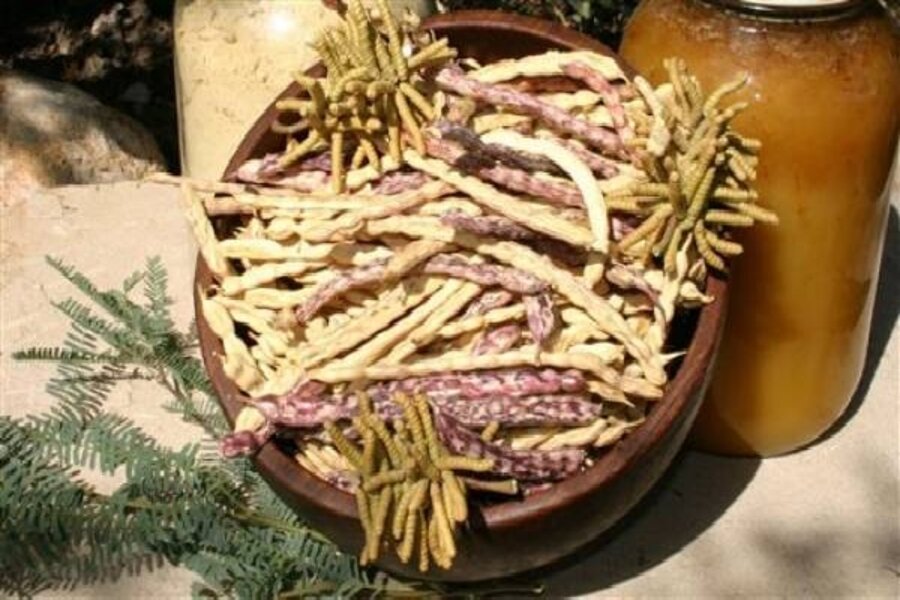In the Southwest, mesquite pods are a tasty treat
Loading...
Each summer, Dana Helfer of Tucson, Ariz., collects the long, yellowish string-bean-like pods produced by mesquite trees on her property and around her neighborhood. And each fall, she has the sweet-tasting pods ground into flour."We use it to make pancakes and waffles, and I'll put it in banana bread, zucchini bread, and smoothies," she says.
Ms. Helfer is a volunteer for Desert Harvesters, a nonprofit group that promotes the use of mesquite pods. They've made countless converts at mesquite pancake breakfasts and milling events each autumn.
"We get a lot of people bringing bags of pods to be milled; some have been doing it for years and others are first-timers," says Helfer.
A 5-gallon bucket of pods yields about 1 pound of flour.
Mesquite has an earthy sweetness, often described as slightly fruity with a hint of caramel. Invariably, Helfer says, newcomers are stunned that they can use it for cooking, and lament that they've been sweeping up the pods and throwing them away. "Most people see the pods as trash," she says.
Native Americans knew better: Mesquite pods were a staple for tribes in southern California, the Great Basin, and the Southwest. Stone pestles were used to grind the seedpods into a coarse meal. The protein-rich flour was used to make small cakes that were eaten dry. It also could be made into mush or mixed with water for a sweet drink.
There are six species of mesquite trees native to the United States, from southern California to Texas and from the Mexican border as far north as Oklahoma. The most common varieties include velvet mesquite and honey mesquite, which can reach heights up to 30 feet, and the more shrublike screw bean mesquite.
Growing mesquite trees is easy, according to Brad Lancaster, a cofounding member of Desert Harvesters. Over the past decade, he has planted hundreds of velvet mesquite trees in his Tucson neighborhood, along with other native, food-bearing shade trees, such as desert ironwood and palo verde.
"I typically buy 5-gallon potted trees from local nurseries," says Mr. Lancaster. "The smaller the tree, the more quickly it will establish. In two years, you can have a 5-gallon potted tree established."
Lancaster dissuades would-be gardeners from planting nonnative South American mesquites, which are shallower-rooting trees prone to leaning and blow-overs. They also require more water than native species and do not produce as many pods, he says.
"Using indigenous species helps to reinvigorate the native flora, and reconnects homeowners with the local ecosystem," Lancaster adds. "Native trees are also likely to be a bigger draw for local wildlife."
Before they start digging a hole, Lancaster urges tree planters to create simple earthworks that channel rainwater runoff to thirsty roots. Sunken, level-bottomed basins should be at least 12 inches deep. In drier climates, mesquites must be regularly watered for the first two or three years.
"After that, they will thrive on their own if planted beside or within a rain garden," says Lancaster.
Beware overwatering, however, and overfertilizing, says Rebecca Senior, an arborist and educator at the Desert Botanical Garden in Phoenix. "Growing the trees too fast can result in a weaker tree."
Eric Clark, a horticulturist and landscape designer at Civano Nursery in Tucson, advises against topsoil and fertilizer when planting mesquite trees.
"Using native soil from your yard to backfill the hole will promote better root growth," he says.
Mesquites thrive in the Southwest partly because they are able to produce their own nitrogen naturally, so there's no need to add fertilizer, Clark says.
"October and November are ideal months to plant mesquite trees," he says.
If you're patient, Lancaster noted that mesquites also germinate readily from seed. After extracting the seed from the pod, the tough seed coat needs to be nicked or chipped (a process known as scarification) and soaked in water.
Foodies take note: The taste of the seed pod can vary from tree to tree, so some home gardeners choose seeds from trees they know produce sweet-tasting pods.
Mesquite trees produce seed pods between June and September. Young trees typically produce in their second year, but it takes a few more years for the trees to produce larger quantities of pods for harvesting.
Ripe pods — yellowish-tan in color — are best picked directly from the tree when they are dry and brittle. Collecting pods from the ground should be avoided, since they may have touched pesticides or animal droppings and are more prone to mold growth.
Carolyn Niethammer, author of "The New Southwest Cookbook" (Rio Nuevo Press), encourages home chefs to experiment with mesquite. Its flour does not contain gluten, she notes, so for baking, you need to mix it with regular flour. A recipe that calls for 1 cup of flour, for example, could combine ¼ to ½ cup of mesquite flour with the balance made up with wheat flour.
Clark says he knows one other use for mesquite flour: "I know people who make homemade dog treats with the ground seedpods."
Editor’s note: For more on gardening, see the Monitor’s main gardening page, which offers articles on many gardening topics. Also, check out our blog archive and our RSS feed. You may want to visit Gardening With the Monitor on Flickr. Take part in the discussions and get answers to your gardening questions. If you join the group (it’s free), you can upload your garden photos and enter contests.





